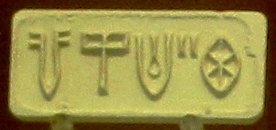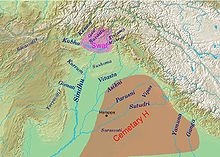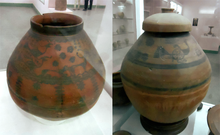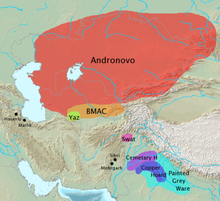
Harappa is an archaeological site in Pakistan, about 25 km (16 mi) north of Sahiwal. The Bronze Age Harappan civilisation, now more often called the Indus Valley Civilisation, is named after the site, which takes its name from a modern village near the former course of the Ravi River, which now runs 8 km (5.0 mi) to the north. The core of the Harappan civilisation extended over a large area, from Gujarat in the south, across Sindh and Rajasthan and extending into Punjab and Haryana. Numerous sites have been found outside the core area, including some as far east as Uttar Pradesh and as far west as Sutkagen-dor on the Makran coast of Balochistan, not far from Iran.

The Indus Valley Civilisation (IVC), also known as the Indus Civilisation, was a Bronze Age civilisation in the northwestern regions of South Asia, lasting from 3300 BCE to 1300 BCE, and in its mature form 2600 BCE to 1900 BCE. Together with ancient Egypt and Mesopotamia, it was one of three early civilisations of the Near East and South Asia, and of the three, the most widespread, its sites spanning an area from much of Pakistan, to northeast Afghanistan, and northwestern India. The civilisation flourished both in the alluvial plain of the Indus River, which flows through the length of Pakistan, and along a system of perennial monsoon-fed rivers that once coursed in the vicinity of the Ghaggar-Hakra, a seasonal river in northwest India and eastern Pakistan.

The Indus script, also known as the Harappan script and the Indus Valley Script, is a corpus of symbols produced by the Indus Valley Civilisation. Most inscriptions containing these symbols are extremely short, making it difficult to judge whether or not they constituted a writing system used to record a Harappan language, any of which are yet to be identified. Despite many attempts, the 'script' has not yet been deciphered, but efforts are ongoing. There is no known bilingual inscription to help decipher the script, which shows no significant changes over time. However, some of the syntax varies depending upon location.

The Indo-Aryan migrations were the migrations into the Indian subcontinent of Indo-Aryan peoples, an ethnolinguistic group that spoke Indo-Aryan languages. These are the predominant languages of today's Bangladesh, Maldives, Nepal, North India, Eastern Pakistan, and Sri Lanka.

The Ochre Coloured Pottery culture (OCP) is a Bronze Age culture of the Indo-Gangetic Plain "generally dated 2000–1500 BCE," extending from eastern Punjab to northeastern Rajasthan and western Uttar Pradesh.

The Painted Grey Ware culture (PGW) is an Iron Age Indo-Aryan culture of the western Gangetic plain and the Ghaggar-Hakra valley in the Indian subcontinent, conventionally dated c.1200 to 600–500 BCE, or from 1300 to 500–300 BCE It is a successor of the Cemetery H culture and Black and red ware culture (BRW) within this region, and contemporary with the continuation of the BRW culture in the eastern Gangetic plain and Central India.

The Gandhara grave culture of present-day Pakistan is known by its "protohistoric graves", which were spread mainly in the middle Swat River valley and named the Swat Protohistoric Graveyards Complex, dated in that region to c. 1200–800 BCE. The Italian Archaeological Mission to Pakistan (MAIP) holds that there are no burials with these features after 800 BCE. More recent studies by Pakistani scholars, such as Muhammad Zahir, consider that these protohistoric graves extended over a much wider geography and continued in existence from the 8th century BCE until the historic period. The core region was in the middle of the Swat River course and expanded to the valleys of Dir, Kunar, Chitral, and Peshawar. Protohistoric graves were present in north, central, and southern Khyber Pakhtunkhwa province as well as in north-western tribal areas, including Gilgit-Baltistan province, Taxila, and Salt Range in Punjab, Pakistan, along with their presence in Indian Kashmir, Ladakh, and Uttarakhand.

Kalibangān is a town located at 29.47°N 74.13°E on the left or southern banks of the Ghaggar in Tehsil Pilibangān, between Suratgarh and Hanumangarh in Hanumangarh District, Rajasthan, India 205 km. from Bikaner. It is also identified as being established in the triangle of land at the confluence of Drishadvati and Sarasvati Rivers. The prehistoric and pre-Mauryan character of Indus Valley civilization was first identified by Luigi Tessitori at this site. Kalibangan's excavation report was published in its entirety in 2003 by the Archaeological Survey of India, 34 years after the completion of excavations. The report concluded that Kalibangan was a major provincial capital of the Indus Valley Civilization. Kalibangan is distinguished by its unique fire altars and "world's earliest attested ploughed field". It is around 2900 BC that the region of Kalibangan developed into what can be considered a planned city.

Amri is an ancient settlement in modern-day Sindh, Pakistan, that goes back to 3600 BCE. The site is located south of Mohenjo Daro on Hyderabad-Dadu Road more than 100 kilometres north of Hyderabad, Pakistan.
Several periodisations are employed for the periodisation of the Indus Valley Civilisation. While the Indus Valley Civilisation was divided into Early, Mature, and Late Harappan by archaeologists like Mortimer Wheeler, newer periodisations include the Neolithic early farming settlements, and use a stage–phase model, often combining terminology from various systems.
Rangpur is an ancient archaeological site in Surendranagar district near Vanala on Saurashtra peninsula in Gujarat, western India. Lying on the tip between the Gulf of Khambhat and Gulf of Kutch, it belongs to the period of the Indus Valley civilization, and lies to the northwest of the larger site of Lothal. It is the type site for the Rangpur culture, a regional form of the late phase of the Indus Valley Civilization that existed in Gujarat during the 2nd millennium BCE.

Pottery in the Indian subcontinent has an ancient history and is one of the most tangible and iconic elements of Indian art. Evidence of pottery has been found in the early settlements of Lahuradewa and later the Indus Valley Civilisation. Today, it is a cultural art that is still practiced extensively in the subcontinent. Until recent times all Indian pottery has been earthenware, including terracotta.

The Harappan language is the unknown language or languages of the Bronze Age Harappan civilization. The Harappan script has long defied attempts to read it, and therefore the language remains unknown. The language being unattested in any readable contemporary source, hypotheses regarding its nature are reduced to purported loanwords and substratum influence, the substratum in Vedic Sanskrit and a few terms recorded in Sumerian cuneiform, in conjunction with analyses of the undeciphered Indus script.
Bara Culture was a culture that emerged in the eastern region of the Indus Valley civilization around 2000 BCE. It developed in the doab between the Yamuna and Sutlej rivers, hemmed on its eastern periphery by the Shivalik ranges of the lower Himalayas. This territory corresponds to modern-day Punjab, Haryana and Western Uttar Pradesh in North India. Older publications regard the Baran pottery to have initially developed independently of the Harappan culture branch of the Indus Valley Civilization from a pre-Harappan tradition, although the two cultures later intermingled in locations such as Kotla Nihang Khan and Bara, Punjab. According to Akinori Uesugi and Vivek Dangi, Bara pottery is a stylistic development of Late Harappan pottery. In the conventional timeline demarcations of the Indus Valley Tradition, the Bara culture is usually placed in the Late Harappan period.
Mitathal is a village and Indus Valley civilization (IVC) Archaeological sites in the Bhiwani tehsil of the Bhiwani district in the Indian state of Haryana. Part of Hisar division, it lies 12 kilometres (7.5 mi) north of the district headquarters Bhiwani and 249 kilometres (155 mi) from the state capital Chandigarh. As of the 2011 Census of India, the village had 1,448 households with a total population of 7,434 of which 4,002 were male and 3,432 female.

Sinauli is an archaeological site in western Uttar Pradesh, India, at the Ganga-Yamuna Doab. The site gained attention for its Bronze Age solid-disk wheel carts, found in 2018, which were interpreted by some as horse-pulled "chariots".

The Jhukar phase was a phase of the Late Harappan culture in Sindh that continued after the decline of the mature Indus Valley civilisation in the 2nd millennium BC. It is named after the archaeological type site called Jhukar in Sindh. It was, in turn, followed by the Jhangar phase.
The Jhangar phase was an archaeological culture, named after the type site Jhangar, that followed the Jhukar phase of the Late Harappan culture in Sindh.
Sothi is an early archaeological site of the Indus Valley civilization dating to around 4600 BCE, located in the Hanumangarh District of Rajasthan, India, at a distance of about 10 km southwest of Nohar railway station.

The religion and belief system of the Indus Valley Civilisation (IVC) people have received considerable attention, with many writers concerned with identifying precursors to the religious practices and deities of much later Indian religions. However, due to the sparsity of evidence, which is open to varying interpretations, and the fact that the Indus script remains undeciphered, the conclusions are partly speculative and many are largely based on a retrospective view from a much later Hindu perspective.


















